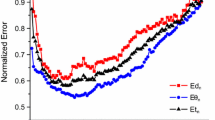Abstract
The signal source impedance Z of implanted pacemaker electrodes plays an important role for adequate sensing of electrogram signals and has so far been little explored. A frequency-domain method for thein vivo calculation of Z is described. Electrogram signals picked up between two electrodes were recorded unloaded, and loaded with resistors and capacitors, then amplified, and stored on magnetic tape. After time sampling and a.d. conversion, the signals were read into a digital computer as discrete time vectors with 2P samples. Each vector was subjected to a fast Fourier transform (f.f.t.), and the ratio H(jωi) between the transformed loaded and unloaded vectors was calculated. For the electrode impedance Z a linear model was chosen that consisted of the tissue and electrode resistance RT, in series with a parallel coupling between Faraday resistance RF, and Helmholtz capacitance CH. By nonlinear regression analysis the parameters (∧) in this model were estimated from the ratios H(jjωi) obtained in patients with permanent pacemaker electrodes, and in patients with temporary multicore wire electrodes after open heart surgery. As an estimate for RT was also used the voltage/current ratio R′T, 90 μs into the stimulation pulse from an external variable parameter pulse generator. The 3-component impedance model described the essential features of the electrode impedance in the frequency range up to 100 Hz. It was found that ĈH, decreased slightly with increasing frequency, and that ŘT in general was larger than R′T. A modified model with frequency dependent parameters was found to obtain a better approach to the experimental data.
Similar content being viewed by others
References
Baker, L. E. (1971) Biomedical applications of electrical-impedance measurements. InIEE Medical Electronics Monographs 1–6 (Eds.Hill, D. W. andWatson, B. W.), Peter Peregrinus Ltd., London, 1–42.
Barold, S. S. andWinner, J. A. (1976) Techniques and significance of threshold measurement for cardiac pacing.Chest,70, 760–766.
Barr, R. andSpach, M. S. (1977) Sampling rates required for digital recording of intracellular and extracellular cardiac potentials.Circulation,55, 40–48.
Cashman, P. M. M. (1977) The use of R-R interval and difference histograms in classifying disorders of sinus rhythm.J. Med. Eng. & Technol.,1, 20–28.
Cochran, W. T., Cooley, J. W., Favin, D. L., Helms, H. D., Kaenel, R. A., Lang, W. W., Maling, G. C., Nelson, D. E., Rader, C. M. andWelch, P. D. (1967) What is the fast Fourier transform.IEEE Trans.,AU-15, 45–56.
Cooley, J. W. andTukey, J. W. (1965) An algorithm for the machine calculation of complex Fourier series.Math. Comput.,19, 297–301.
Dymond, A. M. (1976) Characteristics of the metal tissue interface of stimulation electrodes.IEEE Trans.,BME-23, 274–280.
Epelboin, I. andKeddam, M. (1970) Faradaic impedances: diffusion impedance and reaction impedance.J. Electrochem. Soc.,117, 1052–1056.
Hughes, H. C. Jr.,Brownlee, R. R. andTyers, G. F. O. (1976) Failure of demand pacing with small surface electrodes.Circulation,54, 128–132.
Irnich, W. (1976)Elektroterapi des Herzens—Physiologische und Biotechnische Aspekte. Fachverlag Schiele & Schön, Berlin, 28 and 93–96.
Jaron, D., Briller, S. A., Schwan, H. P. andGeselowitz, D. B. (1969) Nonlinearity of cardiac pacemaker electrodes.IEEE Trans.,BME-16, 132–138.
Klafter, R. D. (1973) An optimally energized cardiac pacemaker.IEEE Trans.,BME-20, 350–356.
Klafter, R. D., Koller, G. K. andVan Duyne, P. D. (1974) Determination of a cardiac pacemaker electrode impedance using a time domain method. In the Proceedings of the 27th ACEMB, Philadelphia, 40.
Kreyszig, E. (1967)Advanced engineering mathematics, New York, John Wiley & Sons Inc., 70 and 551.
Krovetz, L. J. andGoldbloom, S. D. (1974) Frequency content of intravascular and intracardiac pressures and their time derivatives.IEEE Trans.,BME-21, 498–501.
Mindt, W. andSchaldach, M. (1975) Electrochemical aspects of pacing electrodes. InEngineering in Medicine: 1 Advances in pacemaker technology (Eds.Schaldach, M. andFurman, S.), Springer Verlag, 297–305.
Mund, K., Richter, G., Weidlich, E., von Sturm, F. andDavid, E. (1976) Equivalent circuit diagram and power consumption of stimulating electrodes.Bioelectrochemistry and Bioenergetics,3, 272–283.
Ohm, O.-J., Hammer, E. andMörkrid, L. (1977) Biological signals and their characteristics as a cause of pacemaker malfunction. InCardiac pacing (Ed.Watanabe, Y.), Excerpta Medica, Amsterdam, Oxford, 401–404.
Author information
Authors and Affiliations
Rights and permissions
About this article
Cite this article
Mörkrid, L., Ohm, OJ. & Hammer, E. Signal source impedance of implanted pacemaker electrodes estimated from the spectral ratio between loaded and unloaded electrograms in man. Med. Biol. Eng. Comput. 18, 223–233 (1980). https://doi.org/10.1007/BF02443299
Received:
Issue Date:
DOI: https://doi.org/10.1007/BF02443299




